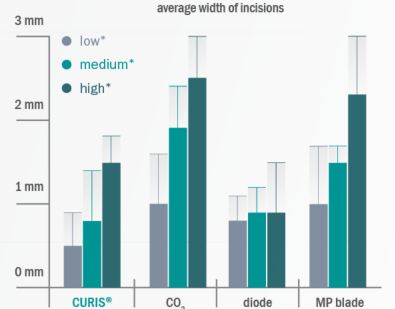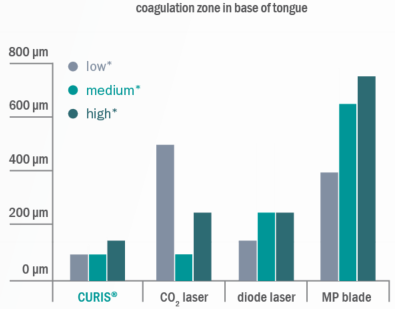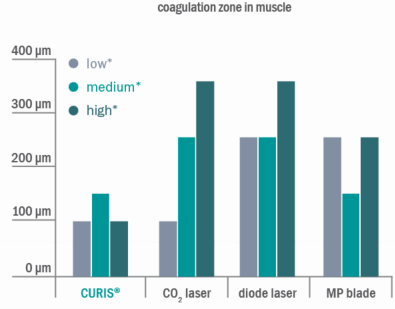
Fig. 1: Comparing the average width of incisions produced by different instruments at different energy levels
This is the conclusion of studies comparing the impedance-controlled CURIS 4 MHz radiofrequency technology with other technologies:
In a study analyzing resection tools suited for transoral robot-assisted surgery, it was shown that the CURIS 4 MHz radiofrequency generator achieved the best cutting width (see fig. 1), the smallest coagulation defects and the narrowest lesions at all energy levels compared to CO2 laser, YAG laser and high frequency technology. Moreover, the CURIS produced the smallest coagulation zone in different tissue types at various energy levels compared to the other technologies (see fig. 2a & 2b). Thus, the impedance-controlled CURIS 4 MHz radiofrequency technology preserves best the tumor-adjacent structures and improves pathological assessment.1

Fig. 1: Comparing the average width of incisions produced by different instruments at different energy levels

Fig. 2a: Comparing the coagulation zone of the instrument in the base of tongue at different energy levels

Fig. 2b: Comparing the coagulation zone of the instrument in muscle tissue at different energy levels
*energy level
Another study among 25 patients presenting with oral or oropharyngeal tumors showed that radiofrequency-assisted resected specimen using the CURIS 4 MHz radiofrequency generator were better assessable than laser-assisted resected specimen. The impedance-controlled 4 MHz radiofrequency technology produced predominantly smooth resection margins and reduced the tissue resistance. Compared to CO2 laser and high frequency technology, the 4 MHz radiofrequency technology caused the narrowest lesions and coagulation zones.2
The impedance-controlled 4 MHz radiofrequency technology also brings about advantages in terms of wound healing and coagulation, as scientific studies show. Learn more and download the full PDF:
Advantages of the Impedance-Controlled 4 MHz Radiofrequency Technology_EN
[1,2 MB]
1 Hoffmann TK et al. Comparative analysis of resection tools suited for transoral robot-assisted
surgery. Eur Arch Otorhinolaryngol 2014; 271:1207-13.
2 Hofauer B et al. Radiofrequency in Oral and oropharyngeal tumor surgery. Auris Nasur Larynx, 2020; 47(1):148 - 153.
Product availability is subject to regulatory approval in individual markets. Products may therefore not be available in all markets.